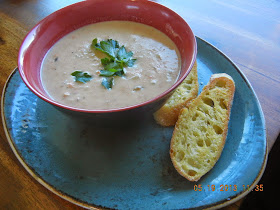Spanish "Horno" -- oven -- for baking bread, on Camino de Santiago, Spain. [Photo by Teri Carns.]

Anyone thinking about food these days can't help but notice that the topic generates a lot of controversy. Is healthy fast food an oxymoron? Is genetic breeding always bad? Is organic always good? Someone is always trying to change the way that you shop, cook, eat your food.
Alaska wheat, Alaska State Fair. [Photo, Teri Carns.]

Wheat is the focus of many of these controversies.
- Dwarf wheats produce at double or triple the rates of earlier plants, but also need great quantities of petroleum-based fertilizers that result in more greenhouse gases in the atmosphere.
- Gluten-free diets, vs. diets with wheat have some people arguing that no human body is actually capable of digesting grains, and they are responsible for the most pernicious diseases of the last couple of centuries, while others say that grains are important to a healthy diet.
- Sustainable harvests, vs. monoculture crops is a debate particularly focused on wheat, along with corn and soy.
- Some authors raise concerns about food as a marker of social class. Locally-grown organic wheats are made into artisan breads at the upper end of the scale, and bleached and enriched flour is used in low-cost breads and hamburger buns at the other end of the scale.
- Nutrient-rich "natural" foods may protect against aging and disease, but foods bred over centuries to serve other needs, such as taste, portability, and disease resistance may lack some specific nutrients.

A recent headline in the New York Times was "Breeding the Nutrition out of our food." The author, Jo Robinson, made the point that people have selectively chosen variations of food over the centuries that are sweeter and more palatable, while sacrificing bitter medicinal qualities. She omitted the discussion of how people also have selected varieties that are more disease resistant, heavier yielding, easier to harvest, and safer to transport. Those points were not relevant to the point that she was making, and she wasn't obliged to mention them. But they're useful to remember.
Urban dandelion, Anchorage, April 21, 2013. Probably not ideal for your salad. [Photo by Teri Carns]

She describes dandelion leaves, for example, as having "seven times the phytonutrients (chemical compounds found in plants with the potential to reduce the risks of several major diseases) of spinach." One immediately thinks that it is simple prejudice that keeps people from selling dandelion leaves. But they are subject to diseases that spinach is not; they often grow near dairy fields and can be contaminated with bacteria from the cows; and they are difficult to harvest. The price could be as low as $5 a pound, a little more than the comparable spinach, but may only be available for a short time during the year.
Foccacia, April 20, 2013. [Photo by Teri Carns.]

Those who insist that modern food is not as good as that eaten by our ancestors often target wheat. The current arguments against wheat include insistence that the new dwarf wheats contain proteins not found in wheat grown before about 1950. The anti-wheat arguments however, often suggest that humans never had the right enzymes to digest grains, and particularly the proteins in wheat (gliadin and glutenin) that allow breads to rise. Some also argue that after gliadin does get digested, it turns into a morphine-like compound that creates cravings for more wheat. The proponents of a wheat-free diet suggest that wheat raises blood sugar more effectively than does candy; that wheat increases inflammation and insulin resistance, and that it makes digestion of minerals difficult or impossible.
L'Opera Ristorante, Long Beach, California, fresh-baked bread, March 2013. [Teri Carns photo]

What are the arguments on the other side? There's a counter to each of the claims made against wheat. One author, writing at berkeleywellness.com, notes that there's no clinical evidence (meaning random, controlled studies that meet the tests for peer-reviewed scientific journals) for the claims that modern wheat affects humans differently or more harmfully than earlier varieties of wheat. Humans have eaten wheat for thousands of years, and in fact the evidence is that human digestive systems developed more amylase after they started eating grains, which permits better digestion of wheat, rye, barley and other grasses.
There is no evidence that eating wheat causes obesity. As the author above at berkeleywellness notes, many other groups of people in the world today eat substantial quantities of the same wheat that we do, and are not obese.
As for the opoid effects of gliadin, researchers at the University of Nebraska-Lincoln said that there was some evidence that in people with celiac disease, there may be some reaction, not fully understood. But the reaction was not known to occur in those who do not have the markers for celiac disease, which is present in less than one percent of the American population [note -- June 30, 2015 -- this link no longer works -- try this one: at webmd.com].
Seed bread, Fire Island Rustic Bakeshop, Anchorage. [Photo, Teri Carns.]
























